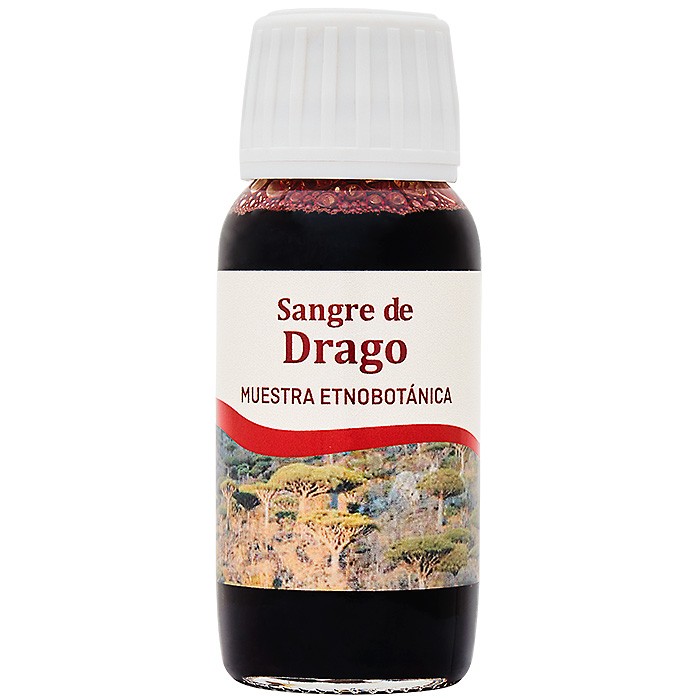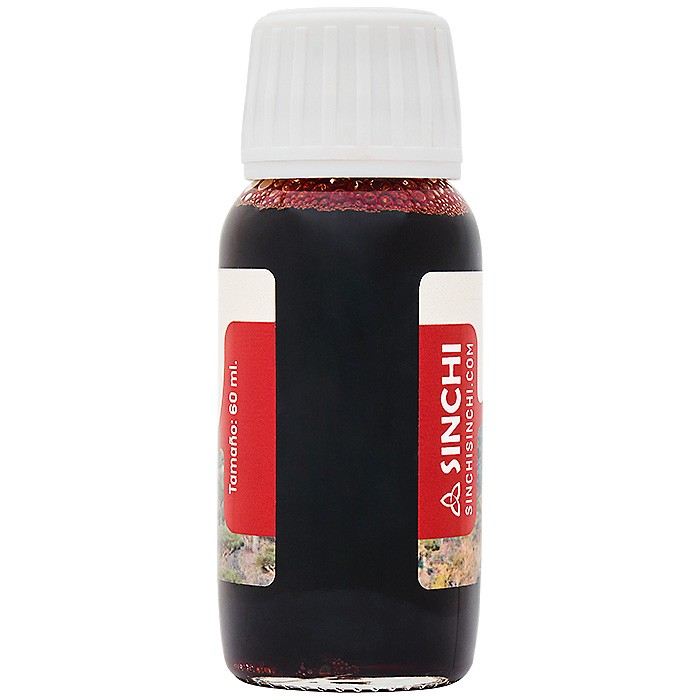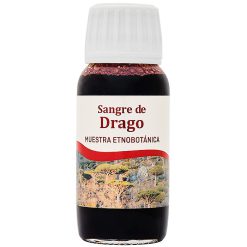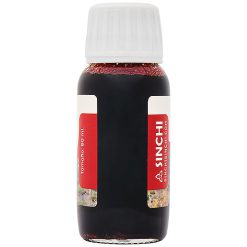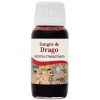Sang de Dragon
32,00€
Sang de dragon extrait de Croton Lechleri en Amazonie. Le sang du dragon est un liquide rougeâtre épais et très foncé dont les propriétés lui confèrent une aura de mystère et une grande admiration depuis l’Antiquité.
Les Amérindiens l’utilisent comme remède médicinal pour une multitude de maux, notamment lorsqu’il est appliqué sur la peau. Historiquement, de nombreux auteurs ont fait référence à ce liquide, le reliant toujours au sang de dragon.
Ce nom est utilisé en médecine traditionnelle sur presque tous les continents, faisant toujours référence à un liquide visqueux et rougeâtre.
Depuis le premier siècle, l’utilisation du sang de dragon se reflète dans la mythologie grecque ; Le sang du dragon, lorsqu’il tomba au sol, donna naissance aux arbres dont la résine est extraite.
En Amérique centrale et du Sud : Au XVIIe siècle, le naturaliste et explorateur espagnol P. Bernabé Cobo décrit ses propriétés curatives. L’utilisation traditionnelle du sang de dragon remonte à des siècles ; En 1600, il était déjà utilisé au Mexique, au Pérou et en Équateur.
Taille : bouteilles de 60 ml
Utilisation ésotérique
Outre son intérêt thérapeutique, on lui attribue des propriétés magiques et il était largement utilisé dans la composition de potions et d’élixirs.
Espèces
Lorsqu’on parle de Sangre de Drago, on se réfère généralement à l’espèce Croton Lechleri Müll Arg., la plus utilisée, bien que depuis l’Antiquité le même nom ait été utilisé pour désigner d’autres espèces aux propriétés similaires des genres Daemonorops, Dracaena et Pterocarpus, principalement :
Asie et Socotra : Daemonorops draco (Willd.) Blume de la famille des Arecaceae.
Îles Canaries, Madère, Maroc et Chine : Genre Dracaena, de la famille des Asparagacées.
Amérique du Sud : Genre Pterocarpus, de la famille des Fabacées.
Utilisation traditionnelle
Le sang du dragon contient l’alcaloïde taspine.
Le sang de dragon est utilisé depuis des siècles par les tribus indigènes d’Amazonie comme médecine naturelle.
L’une des applications les plus courantes du sang de dragon est son utilisation comme agent cicatrisant pour traiter les plaies, les brûlures et les ulcères. Il est appliqué localement sur la peau affectée pour favoriser la régénération des tissus et prévenir l’infection. Il a également été utilisé pour traiter des maladies de la peau telles que l’acné, la dermatite et le psoriasis.
Une autre utilisation médicinale du sang de dragon est comme anti-inflammatoire naturel. Il a été utilisé pour soulager la douleur et l’inflammation.
Ses propriétés antimicrobiennes peuvent aider à combattre les bactéries, les virus et les champignons.
Anti-inflammatoire : Le sang de dragon contient des composés anti-inflammatoires qui peuvent aider à réduire l’inflammation et la douleur.
Antiviral : Le sang de dragon peut être efficace contre certains virus.
Guérison : Le sang de dragon a des propriétés curatives et est utilisé pour traiter les plaies, les brûlures et les ulcères cutanés. Lorsque la résine est appliquée sur la peau, une couche protectrice se forme qui aide à prévenir l’infection et favorise la cicatrisation de la peau. Les principes actifs impliqués dans ce processus sont la taspine et les polyphénols (catéchine et proanthocyanine).
La lignane (3’-4-O-dimethylcedrusina) intervient également dans la cicatrisation et les polyphénols par l’action piégeuse des radicaux libres qui stimulent la contraction des plaies. L’action antibactérienne des polyphénols contribue au processus de cicatrisation.
Antioxydant : Le sang de dragon contient des antioxydants qui aident à protéger les cellules des dommages causés par les radicaux libres.
Analgésique : Le sang de dragon a des propriétés analgésiques qui peuvent aider à soulager la douleur.
Améliore la santé bucco-dentaire : le sang de dragon est utilisé en médecine traditionnelle pour traiter les problèmes dentaires tels que la gingivite, la parodontite et l’halitose. Il s’applique directement sur les dents et les gencives pour soulager la douleur et réduire l’inflammation.
Traitement des maladies de la peau : Le sang de dragon est utilisé pour traiter diverses maladies de la peau, notamment l’eczéma, le psoriasis et l’herpès. Il est appliqué directement sur la peau affectée pour réduire l’inflammation et accélérer la guérison.
Activité antimicrobienne due à la présence de polyphénols, polyacétylènes, flavonols, terpénoïdes, stéroïdes, alcaloïdes, propolis, acide chlorequinique, cobérines A et B et 1,3,5-triméthoxybenzène.
L’activité antibactérienne est due aux composés phénoliques, aux flavonoïdes et aux anthocyanes.
Contient des proanthocyanes, le composant qui lui donne sa couleur rouge.
Histoire
Mythologie grecque
Le Dragonnier tire son nom du dragon qui gardait les pommes d’or du jardin des Hespérides, propriété de la déesse Héra, épouse de Zeus.
Certains situent le Jardin des Hespérides dans les Îles Fortunées, nom sous lequel les îles Canaries sont connues depuis l’Antiquité. Dans ce jardin magique se trouvait un pommier, que Gaïa avait offert à Héra lors de son mariage avec Zeus, dont les fruits d’or accordaient l’immortalité à ceux qui les mangeaient. Ils étaient gardés par un dragon à cent têtes qui ne dormait jamais, appelé Ladon.
Hercule, dans son onzième travail, qui consistait à voler les pommes des Hespérides, tua le dragon d’une flèche bien dirigée, et de chaque goutte de sang qui coula des blessures de Ladon, naquirent des dragons ou arbres appelés dragonniers.
Ces dragonniers étaient appelés Dragos ; en l’honneur du dragon. Son tronc épais, d’où émerge un amas de branches torsadées, rappelle également les cent têtes de Ladon, tandis que la résine rouge qui se détache de son tronc est connue sous le nom de sang de dragon.
Hercule fut le seul à réussir à voler les pommes. Quelque temps plus tard, la déesse Athéna les ramena au jardin des Hespérides.
Mythologie romaine
Pline l’Ancien
Selon Pline, le sang du dragon était le sang versé par le légendaire basilic qui a perdu la vie dans un combat mortel avec un éléphant. Dans son histoire naturelle, il appelle le sang de dragon sanguis draconis, et dit à ce sujet : « c’est le sang d’un dragon écrasé par le poids d’un éléphant en mourant, avec le sang des deux animaux mélangés ensemble. »
L’événement provient probablement de la mythologie indienne, qui raconte la lutte acharnée entre Brahma, le créateur, et Shiva, le destructeur, qui prennent la forme d’un éléphant et d’un cobra ; Pline l’a également suggéré en mentionnant l’Inde comme étant l’origine de cette substance.
Îles Canaries
Le sang de dragon faisait partie des onguents utilisés par les Guanches (anciens aborigènes de l’île de Tenerife, aux îles Canaries, qui l’habitaient avant la conquête castillane en 1496) dans le processus de momification, bien qu’aucune preuve archéologique n’ait été trouvée pour le confirmer.
Au XVe siècle, le sang de dragon était déjà commercialisé en Europe. Au milieu du XIVe siècle, lorsque les premiers contacts modernes s’établirent entre les marins européens et les aborigènes canariens, le prix du sang de dragon était en hausse et son commerce était très rentable, tout comme celui des esclaves, des coquillages, des peaux tannées et de l’orchilla, un lichen utilisé comme colorant et très abondant sur les falaises côtières des îles Canaries.
Le processus d’extraction de la sève a dû influencer le déclin de ces arbres, car elle était obtenue en faisant des coupes trop profondes dans le tronc, ce qui les rendait vulnérables aux bactéries, aux champignons et aux larves d’insectes. À la fin du XVIe siècle, la plupart des dragonniers avaient été asséchés et seuls quelques spécimens survivaient, dont beaucoup sur des falaises inaccessibles.
Amérique du Sud
Christophe Monardes
Les auteurs grecs et romains parlaient souvent de « sang de dragon » pour désigner une substance rouge très précieuse, mais ils ne précisaient pas ce qu’ils entendaient par ce nom.
Les marchands continuèrent à le vendre, sans toutefois savoir si le « sang de dragon » dont parlaient les auteurs classiques était d’origine animale, végétale ou minérale. Il pourrait même s’agir d’une substance mixte, comme l’avait décrit Pline l’Ancien.
Entre 1565 et 1574, Cristóbal Monardes, médecin de Séville, publie son Histoire médicinale des choses apportées de nos Indes occidentales en trois parties. Dans la deuxième partie, il fait référence au dragonnier (édition de 1574). Le livre commence par le titre « Le Dragon » et un dessin du fruit de l’arbre, entier et en coupe, montrant un petit dragon à l’intérieur.
Le passage est le suivant :
Après avoir écrit ce qui a été dit ci-dessus, les deux flottes arrivèrent, l’une de Tierra Firme et l’autre de la Nouvelle-Espagne. Et à Tierra Firme est venu l’évêque de Carthagène, un homme très religieux et savant et très curieux de ces choses, qui m’a cherché immédiatement en arrivant, car il était intéressé par le livre que nous avions fait sur cette question des plantes médicinales.
Je suis allé lui rendre visite, et tandis que nous parlions de beaucoup de choses concernant les herbes et les plantes qui existent dans son diocèse, nous en sommes venus à discuter du sang de dragon, qui est extrait très finement et parfaitement dans cette terre, et il m’a dit : « J’apporte le fruit de l’arbre d’où l’on extrait le sang de dragon, qui est une chose merveilleuse à voir, car il ressemble à un animal. » Je voulus le voir et nous ouvrîmes une feuille de cette graine, et, lorsque nous ouvrîmes la feuille, un dragon apparut, fait avec tant d’artifice qu’il semblait vivant : son cou était long, sa bouche ouverte, son monticule hérissé d’épines, sa queue longue et posée sur ses pieds ; que, certes, il n’y a personne qui le voie qui ne soit étonné de voir sa figure, faite avec un tel artifice qu’elle semble faite d’ivoire, et qu’il n’y a pas d’artisan si parfait qui puisse la rendre meilleure.
Quand j’ai vu cela, j’ai été confronté à autant d’opinions et d’opinions différentes que les anciens en avaient à ce sujet, tant les Grecs que les Latins et les Arabes, disant mille sottises pour tenter de nous apprendre pourquoi on l’appelait sang de dragon : certains disant qu’on le dit parce qu’après qu’un dragon a été tué, on prend ce sang et on le fait avec certaines choses, et c’est pour cette raison qu’ils l’appellent sang de dragon ; D’autres disent que c’est le sang d’un éléphant noyé, avec d’autres choses ; d’autres, que c’est une sorte de vermillon ; d’autres, que c’est le suc de syderitis, une très petite herbe et son suc est très vert ; D’autres disent que c’est le jus d’une racine d’une herbe appelée draconium, et c’est pourquoi ils l’appellent sang de dragon. Voilà ce que disent les anciens et bien d’autres bêtises qu’il serait trop long d’écrire.
Les modernes, suivant cette même ignorance, comme ils le font habituellement dans les choses qui sont douteuses, parce que leur travail n’est pas de dire rien de nouveau, sauf dans ce qui est clair et manifeste, que dans ce qui est douteux et difficile ils le laissent tel qu’ils le trouvent.
Ils délirent tous, comme le faisaient les anciens. Mais le temps, qui est le découvreur de toutes choses, nous a révélé et enseigné ce qu’est le sang du dragon et pourquoi on l’appelle ainsi : et c’est à cause du fruit de cet arbre et du fait qu’il verse cette larme, comme du sang, qui est le fruit dont nous avons parlé. Il s’agit d’un dragon, formé comme la nature a voulu le produire, d’où l’arbre a très clairement tiré son nom.
Car il est commun que les arbres aient des noms pour leurs fruits, par lesquels cet arbre merveilleux a reçu son nom, et en voyant le fruit qu’il porte, transformé en dragon, il nous a libérés de tant de doutes et de tant de confusions que nous voyons écrits par les anciens et les modernes.
Et à partir de maintenant nous serons certains qu’il s’agit de sang de dragon et pourquoi on l’appelle sang de dragon, puisque son fruit donne son nom à l’arbre et à la gomme et aux larmes qui en proviennent, qui sont apportées en excellente qualité de Carthagène, qui sont obtenues en faisant quelques coupes dans l’arbre lui-même, qui, bien qu’étant un très grand arbre, a une écorce très fine qui peut être ouverte avec à peu près n’importe quoi.
De même, elle n’est pas aussi bonne que la térébenthine de Castille, qui est vendue en pains. L’un s’appelle le sang de dragon en gouttes, et l’autre s’appelle le sang de dragon dans le pain.
Tous deux ont la vertu de retenir tout écoulement provenant de l’abdomen, qu’ils soient placés dans l’abdomen ou versés dans des crampons et pris par voie orale. Réduit en poudre et placé sur le tronc cérébral, il empêche la tête de se déplacer vers les parties inférieures. Appliqué sur n’importe quel flux sanguin, il le retient et le stagne.
Consoude et conglutine les plaies fraîches et récentes. Il empêche la chute des dents et favorise la croissance de chair sur les gencives corrodées. C’est une couleur merveilleuse pour les peintres. Et sans cela, il a bien d’autres vertus. J’ai l’intention de planter la graine pour voir si elle germera dans ces régions. Le sang du dragon est considéré comme chaud avec peu de chaleur.
Aujourd’hui, nous savons que ni l’arbre de Carthagène des Indes ni aucun autre arbre connu ne possède de graines ou de fruits ayant la merveilleuse forme de dragon, c’est pourquoi la certitude de Monardes est déconcertante.
Le nom toujours donné à la résine ou larme extraite de l’arbre « sang de dragon » (et non « dragon’s blood ») a naturellement fait penser à l’arbre des Canaries (Dracaena draco), dont le nom « drago » est attesté depuis le XVe siècle.
Dans le texte, il est fait référence à Carthagène [de Indias], et les deux flottes mentionnées sont les groupes de navires marchands escortés par des navires de guerre qui effectuaient des allers-retours réguliers entre l’Espagne et l’Amérique, pour protéger les navires marchands des attaques des pirates et des corsaires.
Monardes ne donne pas le nom de l’évêque de Carthagène qui est venu dans la flotte de Tierra Firme, mais indique que cette arrivée s’est produite alors qu’il avait déjà écrit ce qui précède. Étant donné que son livre a été publié en 1572, le prélat devait être le cinquième de ce diocèse, le docteur Juan de Simancas, originaire de Cordoue et membre du Collège de Bologne, qui, après y avoir servi pendant dix ans, tomba malade et retourna en Espagne, où il mourut en 1570.
De l’histoire, on peut déduire que l’arbre dont ils parlaient n’était pas l’arbre des Canaries, mais un autre d’Amérique du Sud, qui avait été planté dans le diocèse de l’évêque.
Juan Simancas a écrit qu’il existait en fait une résine appelée sang de dragon de Carthagène, qui était extraite de Pterocarpus officinalis Jacq., Pterocarpus draco L.
Dans les nouvelles de Monardes, cependant, toute l’importance est mise sur la forme merveilleuse des graines. Intrigué par ce que lui racontait le prélat, il demanda à les voir et fut étonné d’y trouver un petit dragon si habilement réalisé qu’il ressemblait à une figurine en ivoire.
Sa description et le dessin qui l’accompagne montrent clairement qu’il utilise le mot « dragon » non pas dans le sens de grand serpent, qu’il avait dans les textes classiques, mais dans le sens qui était déjà courant à son époque pour désigner l’animal fabuleux au corps et aux pattes reptiliennes.
Après avoir contemplé la graine en forme de dragon, il était naturel pour Monardes que la résine couleur sang qui germait lorsqu’une incision était pratiquée dans l’écorce de l’arbre soit appelée « sang de dragon ».
///
En 1572, le médecin et chirurgien de Philippe, Juan Fragoso, publia à Madrid un ouvrage qui traitait d’un sujet similaire à celui que Monardes venait d’aborder : Le Discours sur les choses aromatiques.
Ces dernières années, des petits arbres ont été envoyés à Sa Majesté depuis les îles Canaries, qui, à mon avis, ressemblaient un peu à des palmiers et étaient appelés dragonniers, et une fois placés dans ses jardins, ils ont péri, malgré le fait qu’ils aient été offerts en cadeau. Ils ont rassemblé le fruit, qui est comme une silique ou une peau, dans laquelle la graine est enfermée. Une fois ouvert, un dragon avec un long cou, une bouche ouverte, une colline hérissée et une longue queue apparaît. Cela ressort clairement de l’ignorance des anciens et de nombreux modernes, qui n’ont jamais deviné ni réussi à découvrir ce qu’était le sang de dragon et pourquoi on le disait, ne connaissant ni la plante ni l’étymologie du nom.
Ici, on sait faire pousser ces arbres sur un terrain solide, d’où, par incision, sort cette gomme communément appelée sang de dragon en larmes, que certains croient être le véritable cinabre de l’Antiquité.
On vend couramment un autre sang de dragon sophistiqué et artificiel, fabriqué à partir de sang de dragon du Brésil et de résine ou avec un mélange de gomme, qui se distingue du vrai en ce que le faux se dissout dans le vin ou l’eau-de-vie, ce qui n’arrive pas avec le bon.
Concernant la figure du dragon à l’intérieur de la graine, Fragoso explique la même chose que Monardes. Bien que Fragoso ne mentionne pas Monardes, il semble l’avoir en tête et veut même le corriger.
L’arbre dont le fruit contient la figure d’un petit dragon, l’arbre d’où l’on extrait le « sang de dragon », était déjà connu à Madrid depuis des années, car certains spécimens avaient été envoyés des îles Canaries pour les jardins royaux.
En 1601, la traduction latine du livre de Fragoso fut publiée à Strasbourg par Israël Spach, médecin, docteur de l’université de Tübingen et professeur à Strasbourg, où il était né. Lui-même indique dans la préface qu’il s’est limité à réviser et arranger la version inédite d’un autre : « Louis Demoulins de Rochefort, noble français de Blois, qui fut le médecin favori de Marguerite de Valois, sœur de François Ier, roi de France, et conseiller de Manuel Philibert de Savoie. »
Il est donc clair que l’ouvrage du médecin espagnol de Philippe II intéressa immédiatement son collègue français, qui entreprit la traduction en latin très peu de temps après sa publication. Demoulins de Rochefort vécut entre 1515 et 1582.
La Marguerite de Valois mentionnée est la célèbre auteur de l’Heptaméron, plus connue sous le nom de Marguerite de Navarre ou Marguerite d’Angoulême.
Manuel Filiberto de Saboya mentionné dans l’ouvrage était gouverneur des Pays-Bas et commandait l’armée du roi d’Espagne lors de la bataille de Saint-Quentin.

